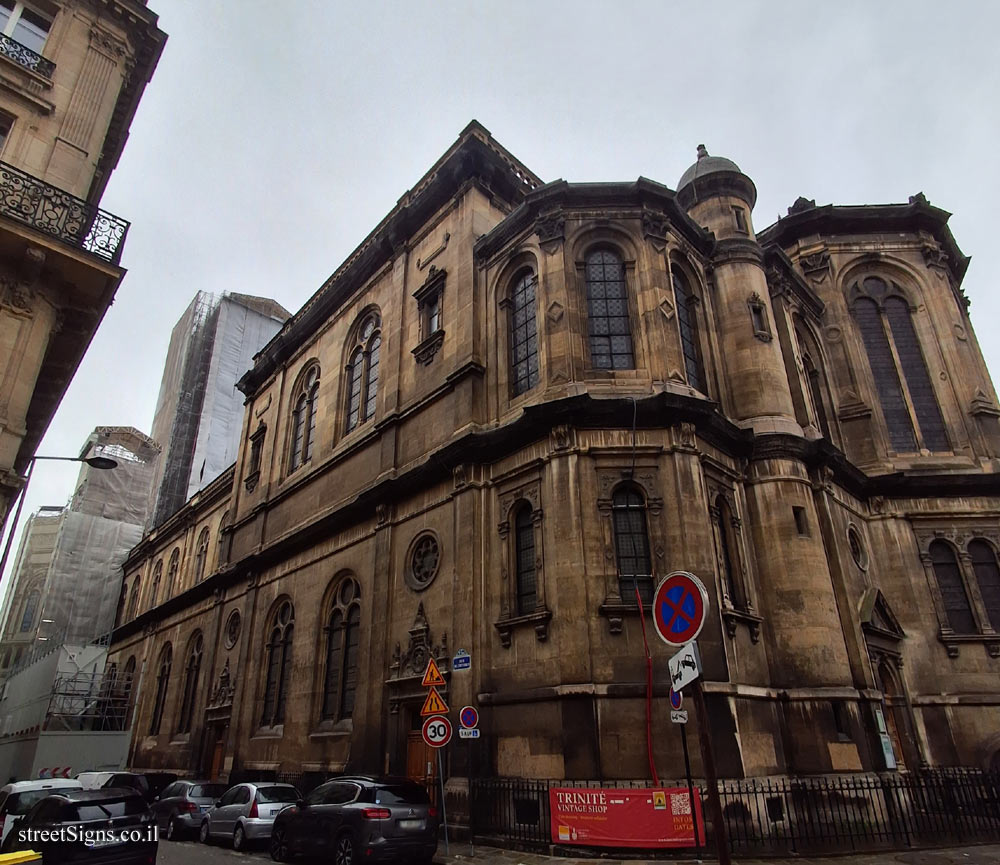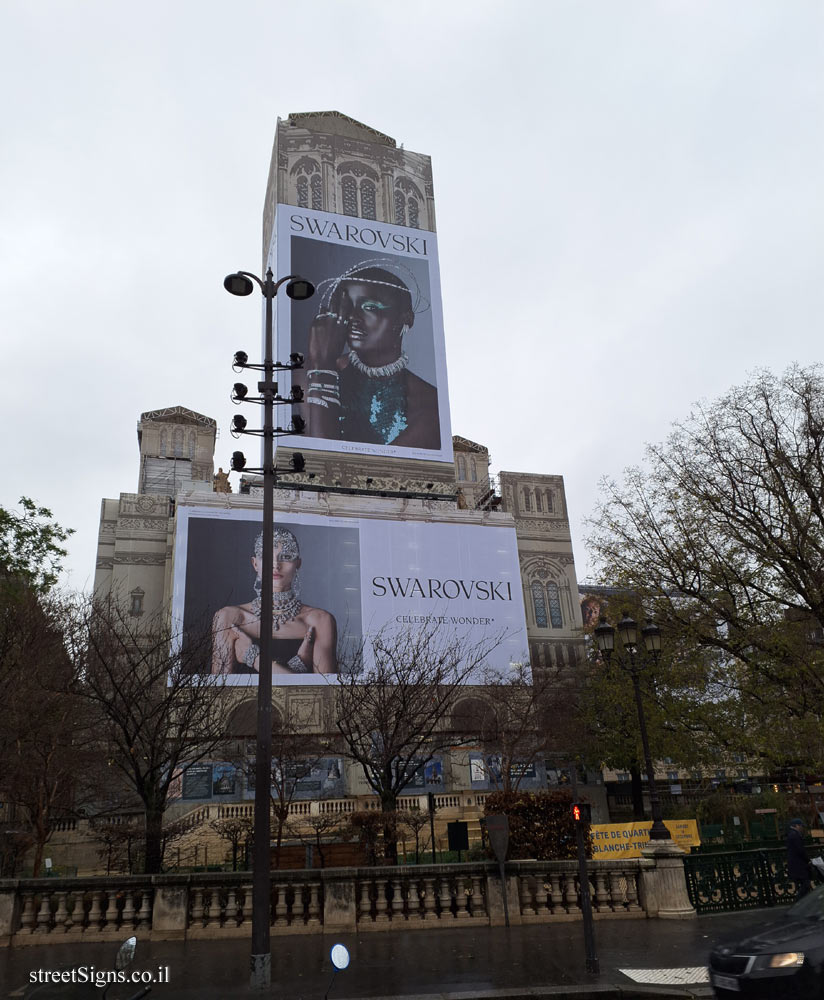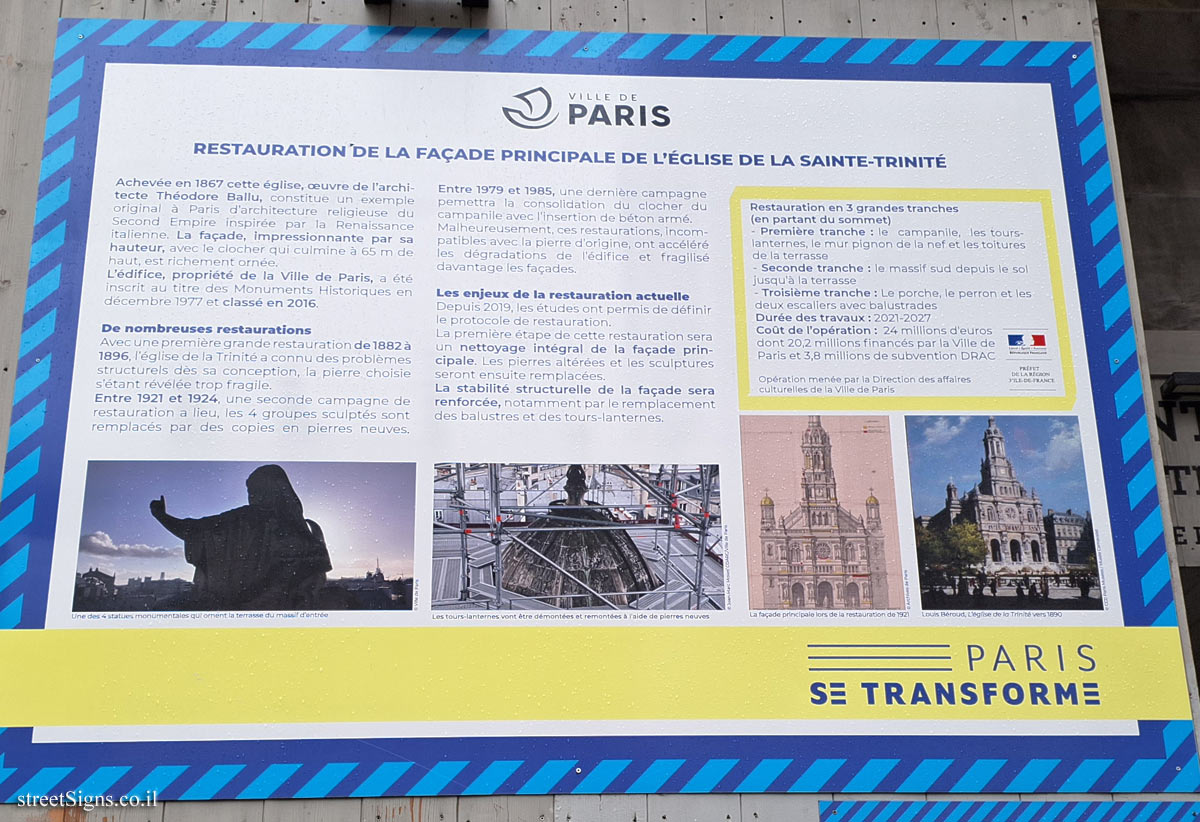One of the series of signs describing historical places in Paris. The signs were placed starting in 1992 and are also called sucettes Starck (Starck’s Lollipops) after Philippe Starck who designed them.
The sign depicts the Church of the Holy Trinity, a Catholic church built between 1861-1867 and designed by Théodore Ballu
The church was photographed on the same day
 Click for a larger image
Click for a larger image  Click for a larger image
Click for a larger image At the time the sign was photographed, the front of the church was being renovated (as you can see in the photo above). The following sign indicates this fact, in addition to other details about the church:
VILLE DE PARIS
RESTAURATION DE LA FAÇADE PRINCIPALE DE L’ÉGLISE DE LA SAINTE-TRINITÉ Achevée en 1867 cette église, œuvre de l’architecte Théodore Ballu, constitue un exemple original à Paris d’architecture religieuse du Second Empire inspirée par la Renaissance italienne. La façade, impressionnante par sa hauteur, avec le clocher qui culmine à 65 m de haut, est richement ornée.
L’édifice, propriété de la Ville de Paris, a été inscrit.au titre des Monuments Historiques en décembre 1977 et classé en 2016.
De nombreuses restaurations Avec une première grande restauration de 1882 à 1896, l’église de la Trinité a connu des problèmes structurels dès sa conception, la pierre choisie s’étant révélée trop fragile.
Entre 1921 et 1924, une seconde campagne de restauration a lieu, les 4 groupes sculptés sont remplacés par des copies en pierres neuves.
Entre 1979 et 1985, une dernière campagne pemettra la consolidation du clocher du campanile avec l’insertion de béton armé. Malheureusement, ces restaurations, incompatibles avec la pierre d’origine, ont accéléré les dégradations de l’édifice et fragilisé davantage les façades.
Les enjeux de la restauration actuelle Depuis 2019, les études ont permis de définir le protocole de restauration.
La première étape de cette restauration sera un nettoyage intégral de la façade principale. Les pierres altérées et les sculptures seront ensuite remplacées.
La stabilité structurelle de la façade sera renforcée, notamment par le remplacement des balustres et des tours-lanternes.
Restauration en 3 grandes tranches
(en partant du sommet) - Première tranche: le campanile, les tourslanternes, le mur pignon dela nef et les toitures de la terrasse
- Seconde tranche: le massif sud depuis.le sol jusqu’à la terrasse
- Troisième tranche: Le porche, le perron et les deux escaliers avec balustrades
Durée des travaux: 2021-2027
Coût de l’opération: 24 millions d’euros dont 20,2 millions financés par la Ville de Paris et 3,8 millions de subvention DRAC
Opération menée par la Direction des affaires culturelles de la Ville de Paris
[Images - from left to right]
Une des 4 statues monumentales qui ornent la terrasse du massif d’entrée
Les tours-lanternes vont être démontées et remontées à l’aide de pierres neúves
La façade principale lors de la restauration de 1921
Louis Béroud, L’église de la Trinité vers 1890
[translation]
CITY OF PARIS
RESTORATION OF THE MAIN FACADE OF THE HOLY TRINITY CHURCH Completed in 1867, this church, the work of architect Théodore Ballu, constitutes an original example in Paris of Second Empire religious architecture inspired by the Italian Renaissance. The façade, impressive for its height, with the bell tower which rises to 65 m high, is richly decorated.
The building, owned by the City of Paris, was registered as a Historic Monument in December 1977 and classified in 2016.
Numerous restorations With a first major restoration from 1882 to 1896, the Trinity Church experienced structural problems from its design, the stone chosen having proved too fragile.
Between 1921 and 1924, a second restoration campaign took place, the 4 sculpted groups were replaced by copies in new stone.
Between 1979 and 1985, a final campaign allowed the consolidation of the bell tower with the insertion of reinforced concrete. Unfortunately, these restorations, incompatible with the original stone, accelerated the deterioration of the building and further weakened the facades.
The challenges of current restoration Since 2019, studies have made it possible to define the restoration protocol.
The first stage of this restoration will be a complete cleaning of the main facade. Weathered stones and sculptures will then be replaced.
The structural stability of the facade will be reinforced, in particular by the replacement of balusters and lantern towers.
Restoration in 3 large installments
(starting from the top) - First section: the campanile, the tower lanterns, the gable wall of the nave and the roofs of the terrace
- Second section: the southern massif from the ground to the terrace
- Third section: The porch, the steps and the two staircases with balustrades
Duration of work: 2021-2027
Cost of the operation: 24 million euros including 20.2 million financed by the City of Paris and 3.8 million from the DRAC subsidy
Operation led by the Cultural Affairs Department of the City of Paris
[Images - from left to right]
One of the 4 monumental statues which adorn the terrace of the entrance massif
The lantern towers will be dismantled and reassembled using new stones
The main facade during the restoration of 1921
Louis Béroud, The Church of the Trinity around 1890
 Click for a larger image
Click for a larger image The church is defined as a historical heritage site of France
Translation of the text on the sign:
[An illustration of a ship, symbolizing the symbol of Paris]
History of Paris Church of the Holy Trinity A decree of December 1860 decided the construction of this church, entrusted to Théodore Ballu (1817-1885), a student of Lebas, in this rapidly changing district of the Chaussée d’Antin. Begun in 1861, the work was completed in 1867. The church was then solemnly handed over by Haussmann to Monseigneur Darbcy. Its very eclectic style, half-Gothic, half-Renaissance, shocked contemporaries. In the square, also designed by Ballu, a resident of the geartier, the allegories of Faith, Hope and Charity, located in the axis of the three semi-circular arcades, dominate the triple basin fountains. The porch of the church is decorated with statues of Saint Gregory, Saint Hilary, Saint Augustine and Saint Athanasius, due to Eugène Guillaume; on the first floor terrace, there are Strength, Justice, Prudence, and Temperance, works by Carpeaux. The originals were replaced by copies, made between the wars. In 1980, renovation of the bell tower and organs of Cavaillé-Coll. In 1891, completing the interior renovation.

 Click for a larger image
Click for a larger image  Click for a larger image
Click for a larger image  Click for a larger image
Click for a larger image